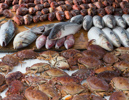Rosarito and the Guadalupe Valley
page 4 of 7
Stephen Fischer Photography
That afternoon was much more productive for photography. We traveled back to the coast and visited the small fishing village of Popotla. Here we found a beach area where many fishermen launch and retrieve their boats, setting up small stands along the beach to display their catch, while various customers come to inspect and purchase these fish. Most of the customers are restuaranteers, picking up fish for the evening menu.
We fanned out for our photography, exploring the various fish on display, the fishermen, and the overall setting of this unique location. You could also see the fishermen clearning their catch or bartering with customers, which made this all the more interesting. I was struck by the number and diversity of fish and crab present at the various stands. They don't seem to use ice, so apparently they need to sell that day what they catch. Based on the volume, it was hard to fathom that all the catch is being sold, and what is happening to the excess?
Photographing Popotla was a unique situation that I have not seen in such a way back in the states. It reflects an unregulated era of the past where people can harvest from the wild and bring it to market with limited encumberances, with the assumption that the supply from nature is unbounded. This is probably also true in many other parts of the world, but one has to wonder how much longer this method will last? It would be interesting to see what the trends are in the volume of catch that is harvested from the sea in places like Popotla over the last few decades.
<page 5 of article continued on the next page>















